Stoelting E111 Service Manual

Model E111 & F111
SERVICE MANUAL
Manual No. 513531-2 |
Dec. 2005 |

This manual provides basic information about the machine. Instructions and suggestions are given covering its operation and care.
The illustrations and specifications are not binding in detail. We reserve the right to make changes to the machine without notice, and without incurring any obligation to modify or provide new parts for machines built prior to date of change.
DO NOT ATTEMPT to operate the machine until instructions and safety precautions in this manual are read completely and are thoroughly understood. If problems develop or questions arise in connection with installation, operation, or servicing of the machine, contact Stoelting.
|
Stoelting Foodservice Equipment |
Customer Service: 888.429.5920 |
|
502 Highway 67 |
Fax: 800.545.0662 |
|
||
|
Kiel, WI 53042-1600 |
Email: foodservice@stoelting.com |
|
||
|
U.S.A. |
|
stoeltingfoodservice.com
Main Tel: 800.558.5807 |
© 2014 PW Stoelting, LLC |
Fax: 920.894.7029 |
|
|
|

A Few Words About Safety
Safety Information
Read and understand the entire manual before operating or maintaining Stoelting equipment.
This manual provides the operator with information for the safe operation and maintenance of Stoelting equipment. As with any machine, there are hazards associated with their operation. For this reason safety is emphasized throughout the manual. To highlight specific safety information, the following safety definitions are provided to assist the reader.
The purpose of safety symbols is to attract your attention to possible dangers. The safety symbols, and their explanations, deserve your careful attention and understanding. The safety warnings do not by themselves eliminate any danger. The instructions or warnings they give are not substitutes for proper accident prevention measures.
If you need to replace a part, use genuine Stoelting parts with the correct part number or an equivalent part. We strongly recommend that you do not use replacement parts of inferior quality.
Safety Alert Symbol:
This symbol Indicates danger, warning or caution. Attention is required in order to avoid serious personal injury. The message that follows the symbol contains important information about safety.
Signal Word:
Signal words are distinctive words used throughout this manual that alert the reader to the existence and relative degree of a hazard.
 WARNING
WARNING
The signal word “WARNING” indicates a potentially hazardous situation, which, if not avoided, may result in death or serious injury and equipment/property damage.
 CAUTION
CAUTION
The signal word “CAUTION” indicates a potentially hazardous situation, which, if not avoided, may result in minor or moderate injury and equipment/property damage.
CAUTION
The signal word “CAUTION” not preceded by the safety alert symbol indicates a potentially hazardous situation, which, if not avoided, may result in equipment/property damage.
NOTE (or NOTICE)
The signal word “NOTICE” indicates information or procedures that relate directly or indirectly to the safety of personnel or equipment/property.
|
TABLE OF CONTENTS |
|
SECTION |
DESCRIPTION |
PAGE |
SECTION 1 |
INTRODUCTION |
|
1.1 |
Description ..................................................................................... |
1 |
1.2 |
Specifications ................................................................................. |
1 |
SECTION 2 |
INSTALLATION INSTRUCTIONS |
|
2.1 |
Safety Precautions ......................................................................... |
3 |
2.2 |
Shipment and Transit ..................................................................... |
4 |
2.3 |
Freezer Installation ......................................................................... |
4 |
2.4 |
Floor Stand Installation ................................................................... |
5 |
2.5 |
Installing Permanent Wiring ............................................................ |
5 |
SECTION 3 |
INITIAL SET-UP AND OPERATION |
|
3.1 |
Operator’s Safety Precautions ........................................................ |
7 |
3.2 |
Operating Controls and Indicators .................................................. |
7 |
3.3 |
Sanitizing ........................................................................................ |
8 |
3.4 |
Freeze Down and Operation ........................................................... |
9 |
3.5 |
Mix Information ............................................................................... |
10 |
3.6 |
Removing Mix Inlet Regulator ......................................................... |
10 |
3.7 |
Cleaning the Freezer ...................................................................... |
11 |
3.8 |
Disassembly of Freezer Parts ......................................................... |
11 |
3.9 |
Cleaning the Freezer Parts ............................................................. |
12 |
3.10 |
Sanitize Freezer & Freezer Parts .................................................... |
12 |
3.11 |
Assembly of Freezer ....................................................................... |
12 |
3.12 |
Routine Cleaning ............................................................................ |
13 |
3.13 |
Preventive Maintenance ................................................................. |
14 |
3.14 |
Extended Storage ........................................................................... |
16 |
SECTION 4 |
REFRIGERATION SYSTEM |
|
4.1 |
Refrigeration System ...................................................................... |
17 |
4.2 |
Evaporators .................................................................................... |
18 |
4.3 |
Compressor Winding Test .............................................................. |
18 |
4.4 |
Condensers .................................................................................... |
19 |
4.5 |
T.X.V. ............................................................................................. |
20 |
4.6 |
T.X.V. Adjustment .......................................................................... |
20 |
4.7 |
T.X.V. Removal .............................................................................. |
20 |
4.8 |
T.X.V. Installation ........................................................................... |
21 |
4.9 |
Hopper............................................................................................ |
22 |
4.10 |
E.P.R. Valve Adjustment ................................................................ |
22 |
4.11 |
E.P.R. Removal .............................................................................. |
23 |
4.12 |
E.P.R. Valve Installation ................................................................. |
23 |
4.13 |
Capillary Tubes ............................................................................... |
24 |
4.14 |
Capillary Tube Removal ................................................................. |
24 |
4.15 |
Capillary Tube Installation ............................................................... |
24 |
4.16 |
Solenoid Valve ................................................................................ |
25 |
4.17 |
Solenoid Magnetic Coil Removal .................................................... |
25 |
4.18 |
Solenoid Magnetic Coil Installation ................................................. |
26 |
4.19 |
Solenoid Valve Removal ................................................................. |
26 |
4.20 |
Solenoid Valve Installation .............................................................. |
26 |
4.21 |
Refrigerant Charge (All Models) ..................................................... |
26 |
SECTION 5 |
CONTROLS |
|
5.1 |
Control System Type 4 ................................................................... |
27 |
5.2 |
Power Board ................................................................................... |
27 |
5.3 |
Program Module ............................................................................. |
27 |
5.4 |
Contactors ...................................................................................... |
34 |
5.5 |
Spigot Switch .................................................................................. |
34 |
5.6 |
Spigot Switch Removal ................................................................... |
34 |
5.7 |
Spigot Switch Installation ................................................................ |
35 |
5.8 |
Front Door Interlock Switch ............................................................ |
35 |
5.9 |
Front Door Interlock Removal ......................................................... |
35 |
5.10 |
Front Door Interlock Switch Assembly ............................................ |
36 |
5.11 |
Touch Pad Switch Module .............................................................. |
36 |
5.12 |
Touch Pad Switch Module Removal ............................................... |
36 |
5.13 |
Touch Pad Switch Module Assembly .............................................. |
36 |
5.14 |
Sensor ............................................................................................ |
37 |
5.15 |
Sensor Removal ............................................................................. |
37 |
5.16 |
Sensor Installation .......................................................................... |
37 |
5.17 |
Preparation for Major Component Removal ................................... |
38 |
5.18 |
Condenser Fan Motor and Lubrication ........................................... |
38 |
5.19 |
Condenser Fan Motor Removal ...................................................... |
38 |
5.20 |
Condenser Fan Motor Installation ................................................... |
39 |
5.21 |
Drive Motor ..................................................................................... |
39 |
5.22 |
Drive Motor Removal ...................................................................... |
39 |
5.23 |
Drive Motor Installation ................................................................... |
40 |
5.24 |
Speed Reducer............................................................................... |
40 |
5.25 |
Speed Reducer Removal................................................................ |
40 |
5.26 |
Speed Reducer Installation ............................................................. |
41 |
5.27 |
Compressor .................................................................................... |
41 |
5.28 |
Compressor Removal ..................................................................... |
41 |
5.29 |
Compressor Installation .................................................................. |
42 |
5.30 |
Final Assembly of Freezer .............................................................. |
43 |
SECTION 6 |
TROUBLESHOOTING |
|
6.1 |
Dispensing, Servability, and Overrun .............................................. |
46 |
6.2 |
Barrel and Hopper Mix Temperature Maintenance ......................... |
47 |
6.3 |
Electro-Mechanical ......................................................................... |
48 |
6.4 |
Control Displayed Error Conditions ................................................. |
54 |
SECTION 7 |
REPLACEMENT PARTS |
|
7.1 |
How To Order Parts........................................................................ |
57 |
|
LIST OF ILLUSTRATIONS |
|
FIGURE |
TITLE |
PAGE |
1 |
Model Endura/Futura 111 Freezer .......................................................... |
1 |
2 |
Specifications ......................................................................................... |
1 |
3 |
Warning Label Locations ........................................................................ |
3 |
4 |
Leveling the Freezer ............................................................................... |
4 |
5 |
Space and Ventilation Requirements ...................................................... |
4 |
6 |
Electrical Plug ......................................................................................... |
4 |
7 |
Installing Tray and Cover ........................................................................ |
4 |
8 |
Floor Stand ............................................................................................. |
5 |
9 |
Power Cord Connection .......................................................................... |
5 |
10 |
Controls .................................................................................................. |
7 |
11 |
Mix Inlet Regulator .................................................................................. |
9 |
12 |
Clean Control.......................................................................................... |
9 |
13 |
Sanitizing Hopper ................................................................................... |
9 |
14 |
Draining Solution .................................................................................... |
9 |
15 |
Dispensing Product ................................................................................ |
10 |
16 |
Removing Mix Inlet Regulator ................................................................. |
10 |
17 |
Draining Mix ........................................................................................... |
10 |
18 |
Auger Flight Wear and Front Auger Support Bushing Wear ................... |
11 |
19 |
Removing Front Door ............................................................................. |
11 |
20 |
Front Door Disassembly ......................................................................... |
11 |
21 |
Removing Auger Support ....................................................................... |
11 |
22 |
Auger Shaft Removal ............................................................................. |
12 |
23 |
Removing “O” Ring ................................................................................. |
12 |
24 |
Cleaning Freezer Barrel .......................................................................... |
12 |
25 |
Exploded View of Auger ......................................................................... |
13 |
26 |
Exploded View of Front Door .................................................................. |
13 |
27 |
Mix Inlet Regulator .................................................................................. |
13 |
28 |
Refrigeration System .............................................................................. |
17 |
29 |
Compressor Terminal Cover .................................................................. |
18 |
30 |
Compressor Connections ....................................................................... |
18 |
31 |
Ohmmeter and Connections ................................................................... |
18 |
32 |
Electrical Box .......................................................................................... |
19 |
33 |
Condenser and Filter .............................................................................. |
19 |
34 |
Condenser Inspection ............................................................................. |
20 |
35 |
T.X.V. (Thermostatic Expansion Valve) .................................................. |
20 |
36 |
Bulb Removal ......................................................................................... |
21 |
37 |
T.X.V. Removal ...................................................................................... |
21 |
38 |
Bulb Installation ...................................................................................... |
22 |
39 |
Filter Drier ............................................................................................... |
22 |
40 |
E.P.R. Schrader Access Fitting .............................................................. |
22 |
41 |
E.P.R. Valve Adjustment ........................................................................ |
23 |
42 |
E.P.R. Valve and Lines ........................................................................... |
23 |
43 |
Filter Drier ............................................................................................... |
24 |
44 |
Capillary Tube and Drive Assembly ........................................................ |
24 |
45 |
Filter Drier ............................................................................................... |
24 |
46 |
Pressure Gauges ................................................................................... |
25 |
47 |
Power Cord ............................................................................................ |
25 |
48 |
Solenoid Replacement............................................................................ |
25 |
49 |
Solenoid Coil Removal ........................................................................... |
26 |
50 |
Power Board ........................................................................................... |
28 |
51 |
Program Module ..................................................................................... |
29 |
52 |
Membrane Switch Panel Display Board .................................................. |
30 |
53 |
Spigot Switch Replacement .................................................................... |
35 |
54 |
Interlock Switch Removal ....................................................................... |
35 |
55 |
Interlock Switch Assembly ...................................................................... |
36 |
56 |
Switch Module Removal ......................................................................... |
36 |
57 |
Cover Plate Removal .............................................................................. |
37 |
58 |
Foam Insulation Removal ....................................................................... |
37 |
59 |
Ty-raps Removal .................................................................................... |
37 |
60 |
Fan Motor Connections .......................................................................... |
38 |
61 |
Fan Bracket Removal ............................................................................. |
39 |
62 |
Drive Belt Removal ................................................................................. |
39 |
63 |
Drive Motor Wire Removal ..................................................................... |
40 |
64 |
Motor Pulley Adjustment ......................................................................... |
40 |
65 |
Belt Tension Adjustment ......................................................................... |
40 |
66 |
Speed Reducer Removal........................................................................ |
41 |
67 |
Speed Reducer Adjustment .................................................................... |
41 |
68 |
Belt Tension Adjustment ......................................................................... |
41 |
69 |
Compressor Cover Removal .................................................................. |
42 |
70 |
Compressor Connections ....................................................................... |
42 |
71 |
Compressor Oil Test Kit ......................................................................... |
42 |
72 |
Filter Drier ............................................................................................... |
43 |
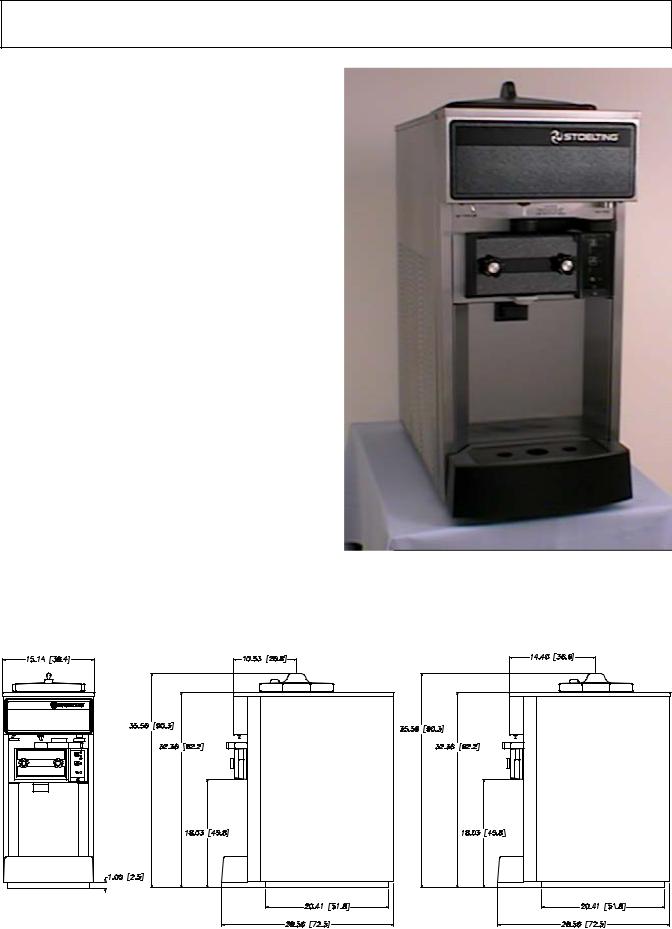
SECTION 1
DESCRIPTION AND SPECIFICATIONS
1.1 DESCRIPTION
The Stoelting Endura/Futura 111/112 counter freezers are gravity fed. The freezers are equipped with fully automatic controls to provide a uniform product. The freezers are designed to operate with almost any type of commercial soft serve or non-dairy mixer available, including ice milk, ice cream, yogurt, and frozen dietary desserts. This manual is designed to assist qualified service personnel and operators in the installation, operation and maintenance of the Stoelting Model Endura 111/112 and Futura 111/112 gravity freezers.
Figure 1. Model Endura/Futura 111/112 Freezer
1.2 SPECIFICATIONS
Model Endura/Futura |
Model Endura/Futura |
Front View |
Side Views |
Figure 2. Specifications
1
MODEL ENDURA/FUTURA111/112
COUNTER MODEL
GRAVITY FREEZER
DIMENSIONS:
Freezer: 15" (38 cm) wide x 28.6" (72 cm) deep x 35.6" (90 cm) high Crated: 19.5" (50 cm) wide x 33" (84 cm) deep x 40" (102 cm) high
WEIGHT: |
|
|
|
Freezer: 230 lbs. (140 kg) |
Crated: 275 lbs. (125 kg) |
||
ELECTRICAL: |
|
|
|
Description |
Endura 111-37G |
Futura 111-38G |
|
Voltage AC |
1 PH 115V |
1 PH 208/230 |
|
Total Run Amps |
12.00 |
|
10.00 |
Drive Motor |
3/4 HP |
|
3/4 HP |
Use 20 amp HACR circuit breaker.
Automatic safeguard circuit built into electronic control-protects major freezer components under abnormal operating conditions.
COOLING:
Air cooled requires minimum 3" (7.6 cm) air clearance on right and left hand side. No clearance needed in the rear.
HOPPER:
3 Gallons (11.5 liters) refrigerated and insulated.
2
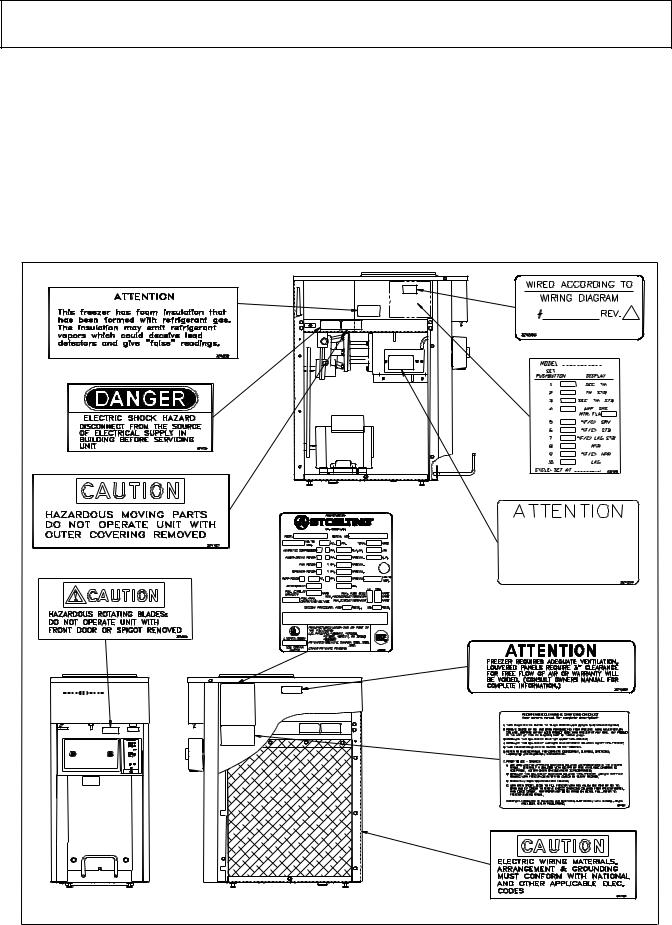
SECTION 2
INSTALLATION INSTRUCTIONS
2.1SAFETYPRECAUTIONS
Do not attempt to operate the freezer until the safety precautions and operating instructions in this manual are read completely and are thoroughly understood.
Take notice of all warning labels on the freezer. The labels have been put there to help maintain a safe working environment. The labels have been designed to withstand washing and cleaning. All labels must remain legible for the life of the freezer. Labels should be checked periodically to be sure they can be recognized as warning labels.
If danger, warning or caution labels are needed, indicate the part number, type of label, location of label, and quantity required along with your address and mail to:
STOELTING, INC.
ATTENTION: Customer Service
502 Hwy. 67
Kiel, Wisconsin 53042
HEAT SENSITIVE THERMISTOR LOCATED
UNDER THIS COVER. TEMPERATURE
MUST NOT EXCEED 220°F NEAR
THERMISTOR. HEAT SINK MUST BE
USED WHEN BRAZING ON EVAPORATOR
OUTLET. CHECK RESISTANCE BEFORE
REMOVAL OF THERMISTOR.
SEE SERVICE MANUAL.
Figure 3. Warning Label Locations
3
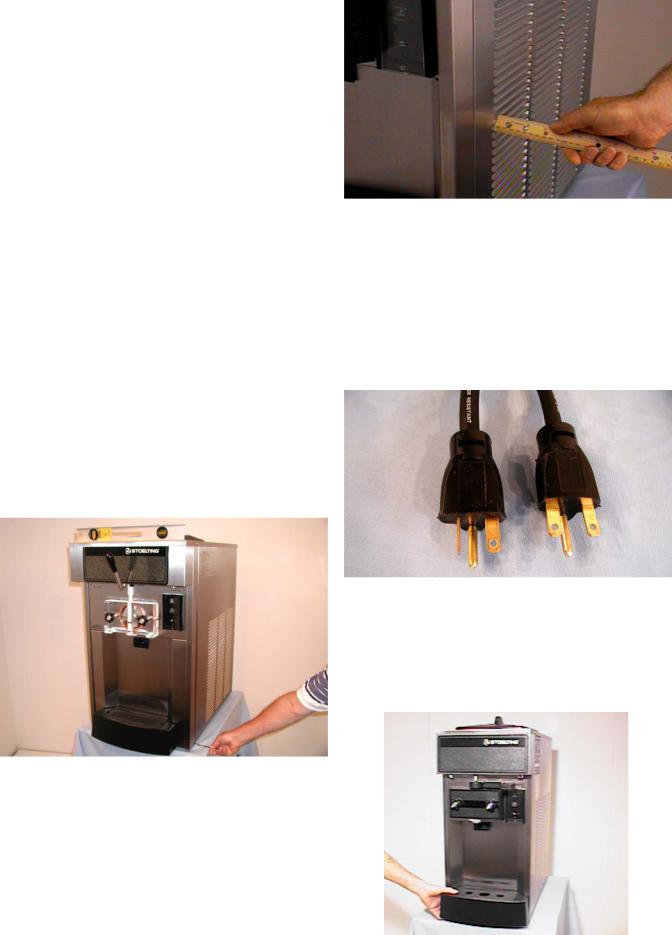
2.2 SHIPMENT AND TRANSIT
The freezer has been assembled, operated and inspected at the factory. Upon arrival at the final destination, the complete freezer must be checked for any damage which may have occurred during transit.
With the method of packaging used, the freezer should arrive in excellent condition. THE CARRIER IS RESPONSIBLE FOR ALL DAMAGE IN TRANSIT, WHETHER VISIBLE OR CONCEALED. Do not pay the freight bill until the freezer has been checked for damage. Have the carrier note any visible damage on the freight bill. If concealed damage and/or shortage is found later, advise the carrier within 10 days and request inspection. The customer must place claim for damages and/or shortages in shipment with the carrier. Stoelting, Inc. cannot make any claims against the carrier.
2.3FREEZERINSTALLATION
Installation of the freezer involves moving the freezer close to its permanent location, removing all crating, setting in place, assembling parts, and cleaning.
A.Uncrate the freezer.
B.Accurate leveling is necessary for correct drainage of freezer barrel and to insure correct overrun. Place a spirit level on top of the freezer at each corner to check for level condition. If adjustment is necessary, level the freezer by turning the bottom part of each leg in or out. Then separate freezer base gasket and install with seam to the back and angle to the top. (Fig. 4).
Figure 4 - Leveling
C.The freezer is equipped with an air cooled condenser and requires correct ventilation. The right side of the freezer is the air intake and left side discharge. Both sides must have 3" clearance the top requires 10" of clearance. (Fig. 5).
CAUTION
FAILURE TO PROVIDEADEQUATE VENTILATION WILL VOID WARRANTY!
D. Place the OFF-ON switch in the OFF position. (Fig.10).
Figure 5. Space and Ventilation Requirements
E.Connect the power cord. The plug is designed for 208 or 230 volt/20 amp duty. Check the nameplate on your freezer for proper supply. The unit must be connected to a properly grounded receptacle. The electrical cord furnished as part of the freezer has a three prong grounding type plug (Fig. 6). The use of an extension cord is not recommended, if necessary use one with a size 12 gauge or heavier with ground wire. Do not use an adapter to get around grounding requirement.
115V |
208/230V |
20 Amp |
20 Amp |
Figure 6. Electrical Plug
CAUTION
DO NOT ALTER OR DEFORM PLUG IN ANY WAY!
F.Install the drip tray, drain tray, hopper cover and other miscellaneous parts on the freezer. (Fig. 7).
Figure 7. Installing Tray and Cover
4
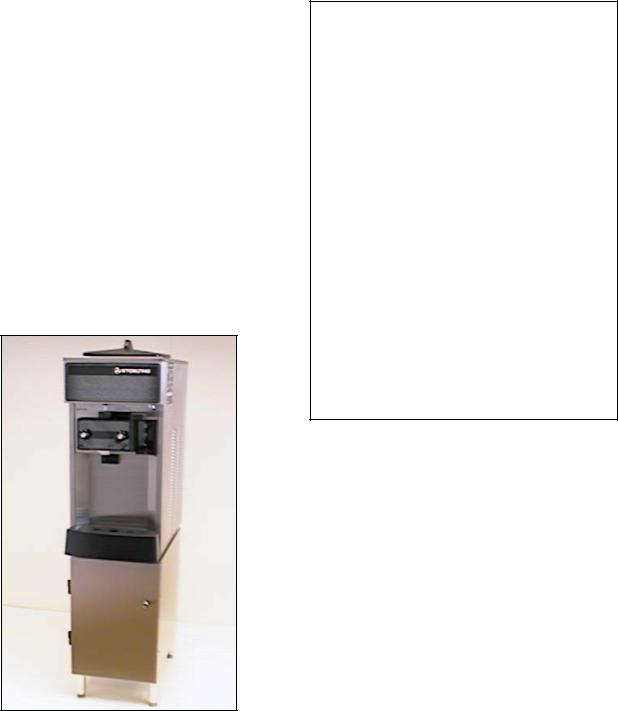
2.4 FLOOR STAND INSTALLATION
To install the E or F111/112 onto the floor stand, follow the steps outlined below:
A.Uncrate the floor stand and place in an upright position.
NOTE
Detailed instructions are included with each floor stand.
B.Place a spirit level across the top of the stand to check for level condition, side to side and front to back. If adjustment is necessary, level the stand by turning the bottom part of each leg in or out, then tighten the lock nut.
WARNING
DO NOT INSTALL CASTERS ON THIS FLOOR STAND. THE STAND IS UNSTABLE WITH CASTERS AND COULD TIP CAUSING SERIOUS INJURY.
C.Place supports under freezer, then remove the 4 legs and replace with the rubber stud/plate mounts provided. Mounts must be fully tightened to the freezer.
D.Place the freezer base gasket on the floor stand with the connected seam to the back and angle side up. Center the gasket side to side and 1-3/4 inches from the rear of the floor stand.
E.Place the freezer on the floor stand with the front of the freezer to the door end. All 4 stud/plate mounts must engage the holes in the floor stand. Secure the mounts with the nuts and washers provided. (Fig. 8).
2.5 INSTALLING PERMANENT WIRING
If permanent wiring is required by local codes, the following procedure must be performed.
WARNING
DISCONNECT FREEZER FROM THE SOURCE OF ELECTRICAL SUPPLY BEFORE SERVICING.
A.Remove the back panel.
B.Disconnect the wires from the terminal
block. Disconnect the green ground wire from the grounding stud. (Fig. 9).
Figure 9. Power Cord Connection
C.Remove the power cord.
D.Install permanent wiring according to local code.
E.Replace the back panel.
Figure 8 - Floor Stand
5
6
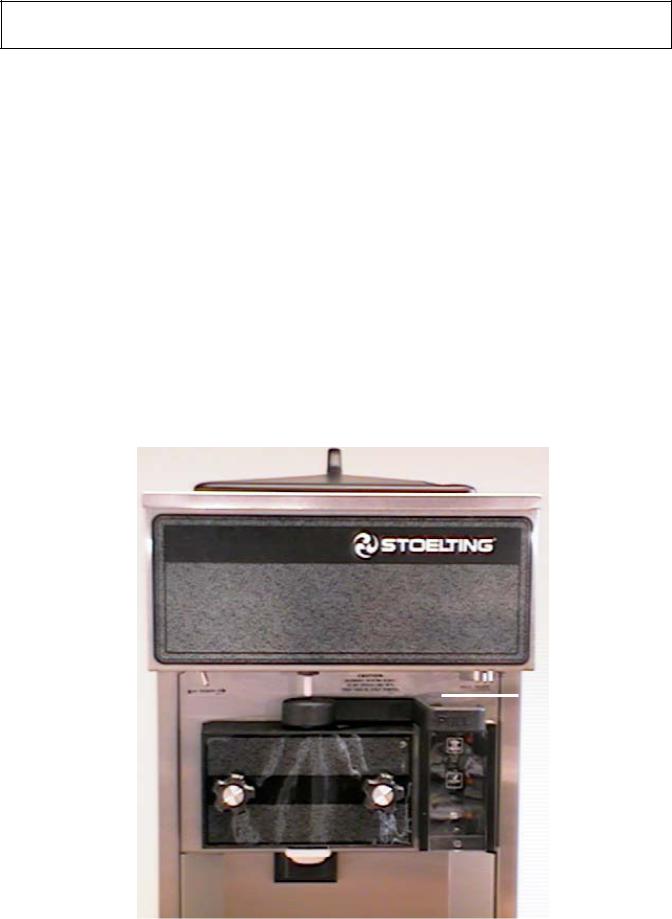
SECTION 3
INITIAL SETUP AND OPERATION
3.1 OPERATOR'S SAFETY PRECAUTIONS
SAFE OPERATION IS NO ACCIDENT; Observe these rules:
A.Know the freezer. Read and understand the Operating Instructions.
B.Notice all warning labels on the freezer.
C.Wear proper clothing. Avoid loose fitting garments, and remove watches, rings or jewelry which could cause a serious accident.
D.Maintain a clean work area. Avoid accidents by cleaning up the area and keeping it clean.
E.Stay alert at all times. Know which switch, push button or control you are about to use and what effect it is going to have.
F.Disconnect electrical cord for maintenance.
Never attempt to repair or perform maintenance on the freezer until the main electrical power has been disconnected.
G.Do not operate under unsafe operating conditions. Never operate the freezer if unusual or excessive noise or vibration occurs.
3.2 OPERATING CONTROLS AND INDICATORS
Before operating the freezer, it is required that the operator know the function of each operating control. Refer to Figure 10 for the location of the operating controls on the freezer. For the information regarding flashing indicator lights, refer to the troubleshooting section.
WARNING
THE OFF-ON SWITCH MUST BE PLACED IN THE OFF POSITION WHEN DISASSEMBLING FOR CLEANING OR SERVICING. THE FREEZER MUST BE DISCONNECTED FROM ELECTRICAL SUPPLY BEFORE REMOVING ANY ACCESS PANEL.
High Pressure Cutout
Switch Located Back
of Freezer
(Some Models)
HOLDREADY
SWITCH
|
|
|
È |
|
Ê |
|
Ç |
OFF-ON |
Ê |
|
|
|
|
||
POWER SWITCH |
|
|
Å |
|
|
SPIGOT SWITCH |
|
|
|
|
Å |
|
|
|
Å |
CONSISTENCY/TEMPERATURE ADJUSTMENT
PUSHTOFREEZE
CLEAN
MIX LOW
Figure 10. Controls
7
A.SPIGOT SWITCH
The SPIGOT switch will automatically actuate the auger drive and refrigeration systems when the spigot is opened to dispense product. When the spigot is closed, the drive motor and compressor will remain "on" until the product in the barrel reaches the proper consistency, or temperature.
B.OFF-ON SWITCH
The OFF-ON switch is a two position toggle switch used to supply power to the control circuit. When the switch is in the OFF position, nothing will run. When the switch is in the ON position the freezer will be in the idle mode until a switch is activated.
F.DRIVE MOTOR OVERLOAD
The internal DRIVE MOTOR OVERLOAD will trip if the drive motor is overloaded. It will reset after approximately 10-12 minutes. If the drive motor continues to trip, refer to Troubleshooting (Sec. 4).
G.RED MIX LOW LENS
The red MIX LOW light is designed to alert the operator to a low mix condition. The lens will illuminate with approximately one gallon of mix in the hopper. When the MIX LOW lens is lit, refill hopper immediately.
NOTE
Failure to refill hopper immediately may result in operational problems.
C.PUSH TO FREEZE SWITCH
The PUSH TO FREEZE switch is a "snap" switch used H. HOLD READY SWITCH
to start the freezing cycle. During initial freeze down, the OFF-ON switch is placed in the ON position. Then the PUSH TO FREEZE switch is pressed until the drive motor and compressor come "ON".
NOTE
After the gearmotor starts, there is a 3 second delay before the compressor starts.
Duringthenormaloperation,theredPUSHTOFREEZE switch light will illuminate after the freezer has been idle for the preset cycles. Before drawing product, press the PUSH TO FREEZE switch if it is illuminated. Wait until the green light is illuminated before dispensing.
NOTE
If the freezer shuts off and the PUSH TO FREEZE light flashes, you have an error condition. Turn the OFF-ON swtich to the OFF position, correct the problem and turn the freezer back on. (See Troubleshooting.)
D.GREENLIGHT
The green light is used to indicate that the product has reached the proper consistency or temperature and is ready to be dispensed.
NOTE
If the PUSH TO FREEZE red light is illuminated, push the PUSH TO FREEZE switch and wait until the green light illuminates before dispensing.
E.CLEAN SWITCH
The CLEAN switch is a "snap" switch. When the switch is pushed the refrigeration system will be OFF and the auger will rotate for cleaning. When the switch is pushed again, the auger will stop and the CLEAN light will flash indicating the freezer is in the CLEAN mode. To exit the CLEAN mode turn the OFF-ON switch to the OFF position. If the freezer is left in CLEAN for more than 30 minutes or is pushed three times in ten seconds, it will go in error. To reset place the CLEAN-OFF-ON switch in the ON position and allow the error light to flash a minimum of 10 minutes. Then turn to off, wait 5 seconds and turn on.
The HOLD READY switch is a push button switch. When pushed in and held for 5 seconds, the hold ready mode will be activated. The product will remain ready to serve and the freezer will not go to idle. To return to normal operation push and hold for 5 seconds.
3.3 SANITIZING
Sanitizing must be done after the freezer is cleaned and just before the hopper is filled with mix. Sanitizing the night before is not effective. However, you should always clean the freezer and parts after using it.
WARNING
THE UNITED STATES DEPARTMENT OF AGRICULTURE AND THE FOOD AND DRUG ADMINISTRATION REQUIRE THAT ALL CLEANING AND SANITIZING SOLUTIONS USED WITH FOOD PROCESSING EQUIPMENT BE CERTIFIED FOR THIS USE.
When sanitizing the freezer, refer to local sanitary regulations for applicable codes and recommended sanitizing products and procedures. The frequency of sanitizing must comply with local health regulations. Mix sanitizer according to manufacturer's instructions to provide a 100 parts per million strength solution. Mix sanitizer in quantities of no less than 2 gallons (7.5 liters) of 120°F water. Allow sanitizer to contact the surfaces to be sanitized for 5 minutes. Any sanitizer must be used only in accordance with the manufacturer's instructions.
NOTE
Stoelting, Inc. has found that STERA-SHEEN GREEN LABEL SANITIZER AND CLEANER does an effective job of properly sanitizing and cleaning a soft serve freezer. We therefore include a sample with each new freezer. Other products may be as effective. For further information refer to cleaning and sanitizing information Section 3.13.
CAUTION
PROLONGED CONTACT OF SANITIZER WITH FREEZER MAY CAUSE CORROSION OF STAINLESS STEEL PARTS.
8
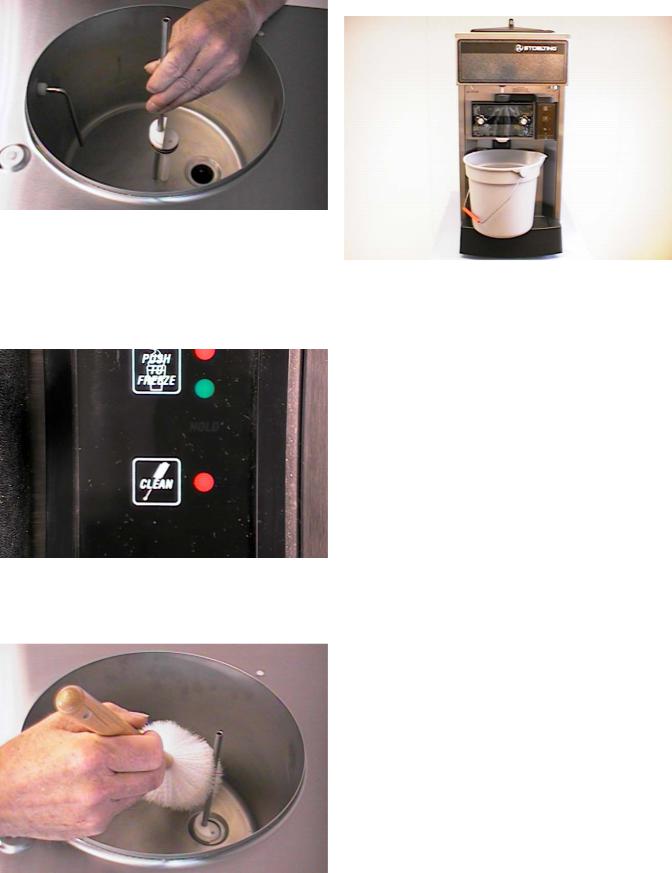
In general, sanitizing may be conducted as follows:
A.Push the mix inlet regulator into hopper with air inlet (long) tube toward the front of the freezer (Fig.11).
E.After five minutes, place a bucket under the spigot and open spigot to drain sanitizing solution. When solution has drained, press the CLEAN snap switch to stop the auger. Allow the freezer barrel to drain completely (Fig. 14).
Figure 11. Mix Inlet Regulator
B.Prepare 2 gallons (7.5 liters) of sanitizing solution following manufacturer's instructions. Pour into hopper with mix inlet regulator in place.
C.Place the OFF-ON toggle switch in the ON position while pressing the CLEAN switch. Check for leaks. (Fig. 12.)
Figure 12. Clean Control
D.Clean sides of hopper, mix inlet regulator and under side of hopper cover using a sanitized soft bristle brush dipped in the sanitizing solution. (Fig. 13).
Figure 13. Sanitizing Hopper
Figure 14. Draining Solution
3.4 FREEZEDOWNANDOPERATION
This section covers the recommended operating procedures to be followed for the safe operation of the freezer.
A.Sanitize just prior to use.
B.Place the OFF-ON switch in the OFF position.
C.With spigot open, pour approximately 1 gallon (3.8 liters) of mix into the hopper. Allow the mix to flush out about 8 ounces (0.23 liters) of sanitizing solution and liquid mix. Close the spigot.
D.Fill hopper with approximately 3 gallons (11.4 liters) of pre-chilled (40°F or 4°C) mix.
CAUTION
DO NOT OVERFILL THE HOPPER. MIX LEVEL MUST NOT BE HIGHER THAN THE AIR INLET TUBE ON THE MIX INLET REGULATOR.
E.The freezer barrel will automatically fill until it is about 1/2 full. If freezer barrel does not fill, check for obstruction in the mix inlet regulator. If freezer barrel fills over 1/2 full, indicated by low overrun, check for leaks at the mix inlet regulator "O" Ring or check if the mix inlet regulator was installed correctly or that the freezer is level.
F.Place the OFF-ON switch in the ON position, then press the PUSH TO FREEZE switch until the freezer starts.
NOTE
After the gearmotor starts, there is a 3 second delay before the compessor starts.
9

G.After about 6 to 10 minutes the freezer will shut OFF and the green lens will illuminate. The product is ready to serve. Freeze down time may be longer for some frozen diet dessert mixes. High ambient temperatures may extend freeze down time.
H.For normal dispensing, move the spigot handle fully open 60° (Fig. 15).
Figure 15. Dispensing Product
CAUTION
REFRIGERATION IS AUTOMATICALLY ACTIVATED WHEN THE SPIGOT IS OPENED. CLOSE THE SPIGOT COMPLETELY AFTER DISPENSING.
I.The freezer is designed to dispense the product at a reasonable draw rate. If the freezer is overdrawn, the result is a soft product or a product that will not dispense at all. If this should occur, allow the freezer to run for approximately 30 seconds before dispensing additional product. After a while the operator will sense or feel when the freezer is beginning to fall behind, and will slow down on the rate of draw so as not to exceed the capacity.
J.Do not operate the freezer when the MIX LOW light is on or with less than 1-3/4 inches (4.4 cm) of mix in the hopper. Refill the hopper immediately.
3.5 MIX INFORMATION
Mix can vary considerably from one manufacturer to another. Differences in the amount of butter-fat content and quantity and quality of other ingredients have a direct bearing on the finished frozen product. A change in freezer performance that cannot be explained by a technical problem may be related to the mix.
Proper product serving temperature varies from one manufacturer's mix to another. Soft serve mixes should provide a satisfactory product in the 18° to 20°F (-7° to -6°C) range, shake mixes 24° to 28°F (-4° to -2°C).
When checking the temperature, stir the thermometer in the frozen product to read the true temperature.
Mix does not improve with age. Old mix, or mix that has been stored at too high temperature, can result in a finished product that is less than satisfactory from the appearanceandtastestandpoint.Toretardbacteriagrowth in dairy based mixes, the best storage temperature range is between 36° to 40°F (2.2° to 4.4°C).
Some products tend to foam more than others. If excess foam should occur, skim off with a sanitized utensil and discard. Periodically, stir the mix in the hopper with a sanitized utensil.
3.6 REMOVING MIX FROM FREEZER
To remove the mix from the freezer, refer to the following steps:
A.Remove the mix inlet regulator from the hopper by pulling straight up (Fig. 16).
Figure 16. Removing Mix Inlet Regulator
B.Place the OFF-ON rocker switch in the ON position and push the CLEAN switch to rotate the auger. Allow the mix to agitate in freezer barrel until the mix has become a liquid, about 5 minutes.
C.Drain the liquid mix by opening the spigot. A bucket or container should be placed under the spigot to catch the liquid mix. (Fig. 17).
D.Place the OFF-ON switch in the OFF position.
Figure 17. Draining Mix
10
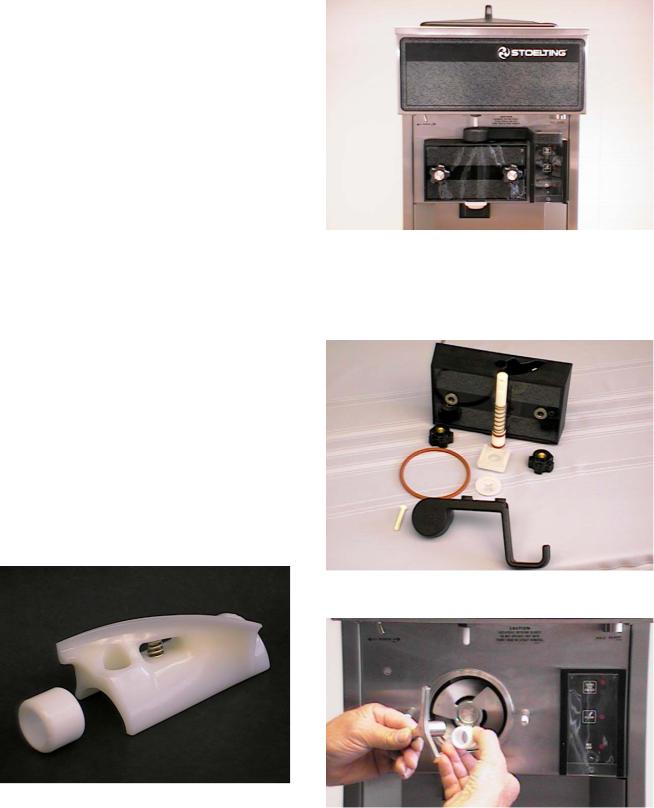
3.7 CLEANINGTHEFREEZER
NOTE
The frequency of cleaning the freezer and freezer parts must comply with local health regulations.
After the mix has been removed from the freezer, the freezer must be cleaned. To clean the freezer, refer to the following steps:
A.Close the spigot and fill the hopper with 2 gallons (7.5 liters) of cold tap water.
B.Place the OFF-ON switch in the ON position while pushing the CLEAN switch to rotate the auger.
C.Allow the water to agitate for approximately 5 minutes.
NOTE
If freezer is left in CLEAN for more than 30 minutes, it will go to error.
D.Open the spigot to drain the water. Remember to place a bucket or container under the spigot to catch the water. When the water has drained, turn the OFF-ON switch to the OFF position. Allow the freezer barrel to drain completely.
E.Repeat Steps A through D using a mild detergent solution.
3.8 DISASSEMBLY OF FREEZER PARTS
CAUTION
PLACE THE OFF-ON TOGGLE SWITCH IN THE OFF POSITION BEFORE DISASSEMBLING FOR CLEANING OR SERVICING.
Inspection for worn or broken parts should be made at every disassembly of the freezer for cleaning or other purposes. All worn or broken parts should be replaced to ensure safety to both the operator and the customer and to maintain good freezer performance and a quality product. Two normal wear areas are the auger flights and front auger support (Fig.18). Frequency of cleaning must comply with the local health regulations.
Figure 18. Auger Flight Wear and Front Auger
Support Bushing Wear
To disassemble the freezer, refer to the following steps:
A.Remove hopper cover and drain tray (Fig. 19).
B.Remove the mix inlet regulator from the hopper by pulling straight up.
C.Remove the front door by turning off the circular knobs and then pulling the front door off the studs.
ËHopper Cover
Drain Tray Æ
Figure 19. Removing Front Door
D.Remove the rosette and adapter, then remove the spigot body from the front door by pulling the clevis pin out of the spigot handle. Push the spigot body through the bottom of the front door (Fig. 20). Remove spigot body and spring.
Figure 20. Front Door Disassembly
E. Remove the front auger support and bushing (Fig. 21).
Figure 21. Removing Auger Support
11
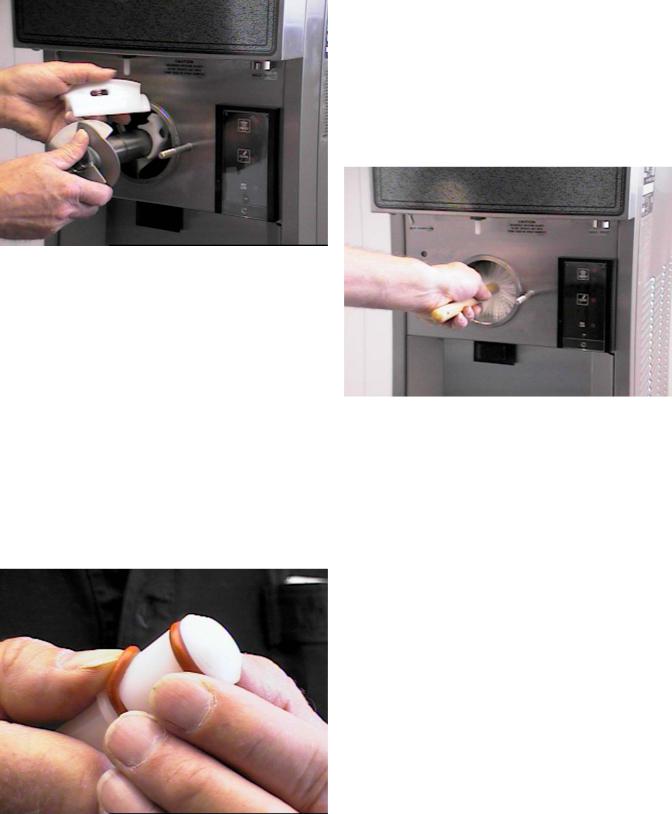
F.Remove the auger assembly from the freezer (Fig. 22). Pull the auger out of the freezer barrel slowly. As the auger is being pulled out, carefully remove each of the plastic flights with springs.
Figure 22. Auger Shaft Removal
G.Keep the rear of the auger shaft tipped up once it is clear of the freezer to avoid dropping rear seal.
H.Remove the rear seal.
I.Wipe socket lubricant from the drive end (rear) of the auger with a cloth or paper towel.
J.Remove all "O" Rings from parts by first wiping off the lubricant using a clean paper towel. Then squeeze the "O" Ring upward with a dry cloth (Fig. 23). When a loop is formed, roll out of the "O" Ring groove.
WARNING
DO NOT USE ANY TYPE OF SHARP OBJECT TO REMOVE THE "O" RINGS.
Figure 23. Removing "O" Ring
3.9 CLEANINGTHEFREEZERPARTS
Place all loose parts in a pan or container and take to the wash sink for cleaning. To clean freezer parts refer to the following steps:
A.Place all parts in warm mild detergent water and clean with brushes provided. Rinse all parts with clean hot water.
CAUTION
DO NOT DAMAGE PARTS BY DROPPING OR ROUGH HANDLING.
B.Wash the hopper and freezer barrel with warm detergent water and brushes provided. (Fig. 24).
Figure 24. Cleaning Freezer Barrel
C.Clean the drip tray and insert with a soap solution. Rinse with clean hot water.
3.10SANITIZEFREEZERANDFREEZERPARTS
A.Use a sanitizing solution of 100 parts per million to sanitize the parts before assembly.
B.Place all parts in the sanitizing solution, then remove and let air dry.
C.Using this sanitizing solution and the large barrel brush provided, sanitize the rear of the barrel by dipping the brush in the sanitizing solution and brushing.
3.11ASSEMBLYOFFREEZER
To assemble the freezer parts, refer to the following steps:
NOTE
Petro-Gel sanitary lubricant or equivalent must be used when lubrication of parts is specified.
NOTE
The United States Department of Agriculture and the Food and Drug Administration require that lubricants used on food processing equipment be certified for this use. Use lubricants only in accordance with the manufacturer's instructions.
12
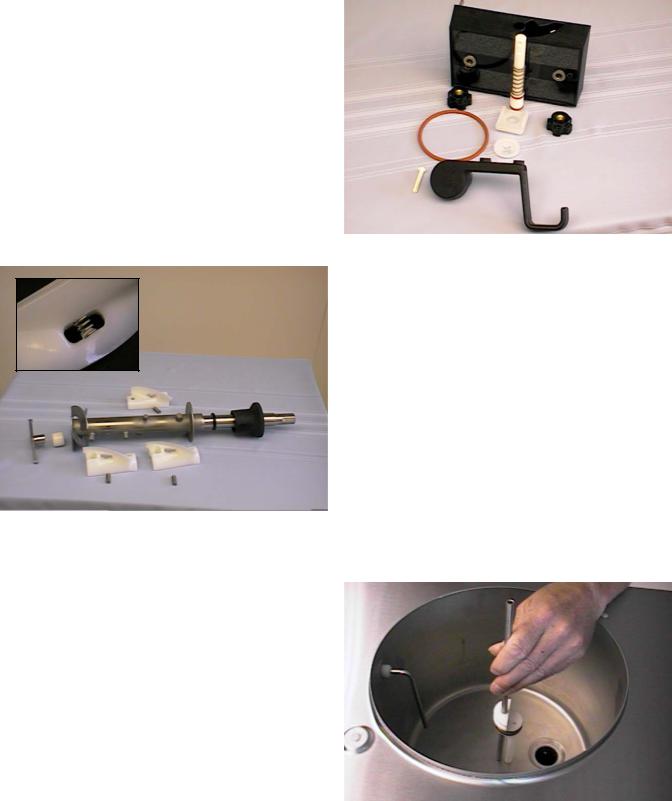
A.Assemble all "O" Rings onto parts dry, without lubrication. Then apply a thin film of sanitary lubrication to exposed surfaces of the "O" Rings. Apply a thin film of sanitary lubricant to metal part of rear seal. Also apply a thin film of sanitary lubricant inside and outside of the front auger support bushing.
B.Assemble the rear seal onto the auger with the large end to the rear. Be sure the "O" Ring is in place before installing the rear seal.
C.Lubricate the auger drive (rear) with a small amount of white socket lubricant. A small container of socket lubricant is shipped with the freezer.
D.Screw the springs onto the studs in plastic flights.
Springs must be screwed into the flights completely to provide proper compression (Fig. 25).
Figure 25. Exploded View of Auger (E111 Shown)
CAUTION
DO NOT PLACE THE MIX INLET REGULATOR INTO THE HOPPER BEFORE INSTALLING THE AUGER.
E.Install the two plastic flights onto rear of the auger and insert part way into freezer barrel.
F.Install the remaining plastic flights, push the auger into the freezer barrel and rotate slowly until the auger engages the drive shaft.
G.Install the bushing and auger support into the front of the auger with one leg of the support pointing straight up.
NOTE
Apply a small amount of Petro-Gel to the surface of the cam on the spigot handle prior to assembly of handle to the spigot body.
H.Install the spigot body with "O" Rings and spring into the front door from bottom (Fig. 26). Push straight up until the spigot is in place. Place the spigot handle on top of the spigot and insert clevis pin, then install the adapter and rosette.
Figure 26. Exploded View of Front Door
NOTE
The spigot handle can only be installed one way.
I.Install the front door on the freezer. Shoulder on the rear of the door must be inside of freezer barrel.
J.Install the circular knobs on the freezer studs.
CAUTION
FINGER TIGHTEN THE CIRCULAR KNOBS EVENLY. DO NOT OVERTIGHTEN KNOBS.
Look for the proper seal between the freezer barrel, "O" Ring, and front door.
K.Install the mix inlet regulator into the freezer with the air tube to the front of the freezer (Fig. 27).
L.Install hopper cover and drain tray.
Figure 27. Mix Inlet Regulator
3.12ROUTINECLEANING
To remove spilled or dried mix from the freezer exterior, simply wash in the direction of the finish with warm soapy water and wipe dry. Do not use highly abrasive materials as they will mar the finish.
13
3.13PREVENTIVEMAINTENANCE
It is recommended that a maintenance schedule be followed to keep the freezer clean and operating properly.
A.Cleaning and Sanitizing Information
Soft serve freezers require special consideration when it comes to food safety and proper cleaning and sanitizing.
The following information has been compiled by Purdy Products Company, makers of Stera-Sheen Green Label Cleaner/Sanitizer and specifically covers issues for cleaning and sanitizing frozen dessert machines. This information is meant to supplement a comprehensive food safety program.
Soil Materials Associated with Frozen Dessert Machines
MILKFAT/BUTTERFAT – As components of icecream/frozen custard mix, these soils will accumulate on the interior surfaces of the machine and its parts. Fats are difficult to remove and help attribute to milkstone build-up.
MILKSTONE – Is a white/gray film that forms on equipment and utensils that come in contact with dairy products. These films will accumulate slowly on surfaces because of ineffective cleaning, use of hard water, or both. Milkstone is usually a porous deposit, which will harbor microbial contaminants and eventually defy sanitizing efforts.
Once milkstone has formed, it is very difficult to remove. Without using the correct product and procedure, it is nearly impossible to remove a thick layer of milkstone.
(NOTE: general-purpose cleaners DO NOT remove milkstone.) This can lead to high bacteria counts and a food safety dilemma.
IT IS BEST TO CONTROL MILKSTONE ON A DAILY BASIS BEFORE IT CAN BECOME A SIGNIFICANT FOOD SAFETY PROBLEM.
In addition to food safety, milkstone can cause premature wear to machine parts which can add to costs for replacement parts or possibly more expensive repairs if worn machine parts are not replaced once they have become excessively worn.
Important Differences Between Cleaning and
Sanitizing
CLEANINGvs.SANITIZING
It is important to distinguish between cleaning and sanitizing. Although these terms may sound synonymous, they are not. BOTH are required for adequate food safety and proper machine maintenance.
CLEANING
·Is the removal of soil materials from a surface.
·Is a prerequisite for effective sanitizing.
NOTE
An UNCLEAN surface will harbor bacteria that can defy sanitizing efforts.
Bacteria can develop and resist sanitizing efforts within a layer of soil material (milkstone). Thorough cleaning procedures that involve milkstone removal are critical for operators of frozen dessertmachines.
SANITIZING
·Kills bacteria.
·Can be effective on clean surfaces only.
NOTE
Using a SANTITIZER on an unclean surface will not guarantee a clean and safe frozen dessert machine.
Proper Daily Maintenance:
The Only Way to Assure Food Safety and Product Quality
Proper daily maintenance can involve a wide variety of products and procedures. Overall, the products and procedures fall into three separate categories.
(Please note that this is a brief overview intended for informational purposes only.)
1.CLEANING – This involves draining mix from the freezer barrel and rinsing the machine with water. Next, a cleaner is run through the machine. Then, the machine is disassembled and removable parts are taken to the sink for cleaning.
2.MILKSTONE REMOVAL – Since almost all cleaners do not have the ability to remove milkstone, the use of a delimer becomes necessary. Although this procedure may not be needed on a daily basis, it will usually follow the cleaning procedure. It requires letting a delimer solution soak in the machine for an extended period of time. Individual parts are also soaked in a deliming solution for an extended period of time (more about delimers in Additional Information).
14
3.SANITIZING – After the machine has been cleaned and contains no milkstone, the machine is reassembled. Then a FDA-approved sanitizing solution is run through the machine to kill bacteria. The machine is then ready for food preparation.
As a recommended cleaner and sanitizer for your frozen dessert machine, STERA-SHEEN has proven to be one of the best daily maintenance products for:
·CLEANING – Thorough removal of all solids including butterfat and milk fat.
·MILKSTONE REMOVAL – Complete removal of milkstone.
·SANITIZING – FDA-approved no rinse sanitizer for food contact surfaces.
Additional Information
THE USE OF DELIMERS
A delimer is a strong acid that has the ability to dissolve milkstone. This type of chemical may become necessary once high levels of milkstone have developed. While these products are very effective for removing HIGH levels of milkstone, they are not ideal for two reasons:
1.PRODUCT SAFETY – Strong acids are dangerous chemicals and handling them requires safety
2.MACHINE DAMAGE – Strong acids will attack metal and rubber causing premature wear of parts. The use of a delimer needs to be closely monitored to avoid damage to machine surfaces and parts.
With proper daily use of STERA-SHEEN or it’s equivalent, there is no need for the use of a
DELIMER.
DO NOT USE BLEACH
·BLEACH HAS ABSOLUTELY NO CLEANING PROPERTIES.
·BLEACH IS CORROSIVE. It can and will damage components of the machine causing premature wear and metal corrosion.
GENERALPURPOSECLEANERS
THE USE OF CHLORINE TEST STRIPS
“Test strips” are used to determine concentrations of active chlorine in sanitizing solutions. To use the strips, tear off a small portion and submerge it into the sanitizing solution. Then, compare the color change to the color key on the side of the test strip dispenser to determine the approximate chlorine concentration.
The ideal concentration of chlorine needs to be 100 ppm (as stated by the FDA).
NOTE
Follow the directions on the container for proper concentration.
There are two main factors that contribute to falling chlorine concentrations in a sanitizing solution.
1.PRODUCT USE – As the chlorine in the solution is being used, chlorine concentrations fall.
2.TIME – As time passes, small amounts of chlorine “evaporate” from the solution. (That is why you can smell it.)
Sanitizing solutions should not be allowed to fall below 100 ppm chlorine. New solutions should be mixed once old solutions become ineffective
WARNING
NEVER ATTEMPT TO REPAIR OR PERFORM MAINTENANCE ON FREEZER UNTIL THE MAIN ELECTRICAL POWER HAS BEEN DISCONNECTED.
B.DAILY
1.The exterior should be kept clean at all times to preserve the lustre of the stainless steel. A mild alkaline cleaner is recommended. Use a soft cloth or sponge to apply the cleaner.
CAUTION
DO NOT USE ACID CLEANERS, STRONG CAUSTIC COMPOUNDS ORABRASIVE MATERIALS TO CLEAN ANY PART OF THE FREEZER EXTERIOR OR PLASTIC PARTS.
C. WEEKLY
General purpose cleaners do not have the ability to remove milkstone. Milkstone will become a problem if not remedied with additional products and procedures.
1.Check "O" Rings and rear seal for excessive wear and replace if necessary.
2.Remove the drip tray by gently lifting up to disengage from the support and pulling out. Clean behind the drip tray and front of the freezer with a soap solution.
15
